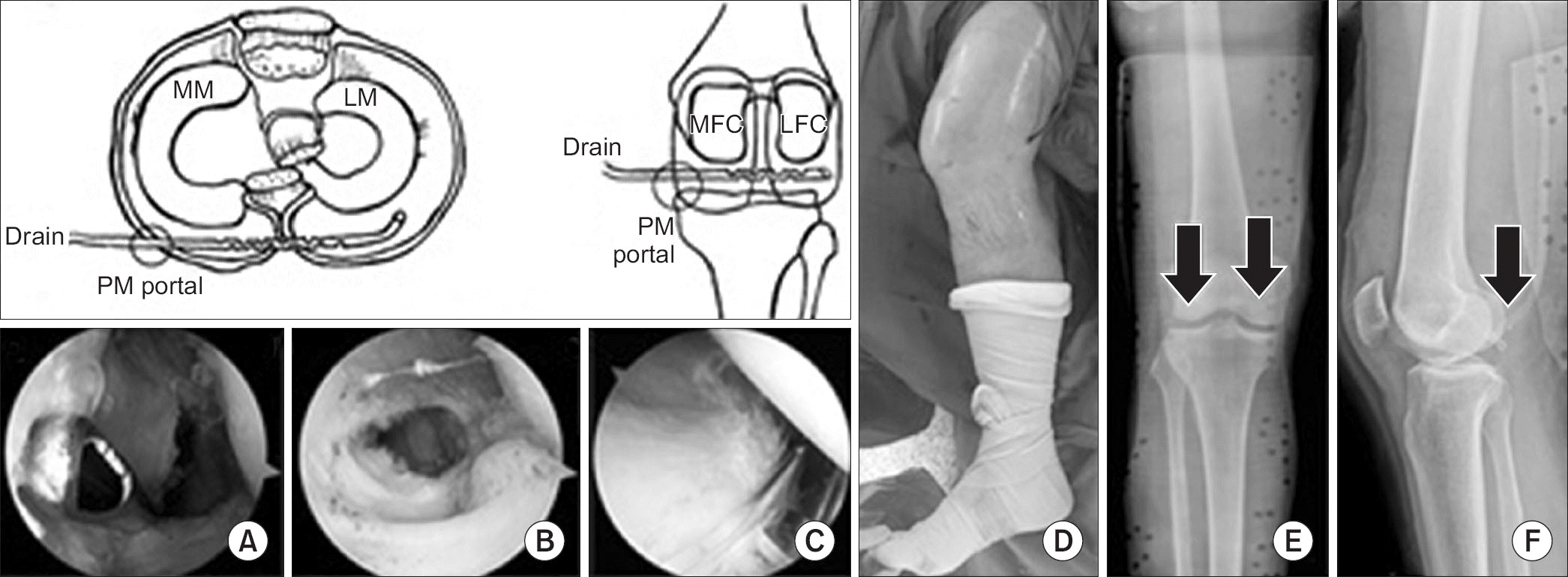Abstract
Purpose:
This study analyzed the treatment effects of drain insertion in the posteromedial portal after an arthroscopic synovectomy and posterior septum resection for pyogenic arthritis.
Materials and Methods:
From June 2005 to December 2016, 56 cases (55 patients, 1 case of bilateral knee) were diagnosed with pyogenic arthritis and arthroscopic treatment was performed. Fourteen patients (25.0%) were identified with causative organisms. The average follow-up period was 12.3 months, and the mean age was 67.8 years old. Twenty-four cases were males and 31 cases were females. Kellgrene–Lawrence grade (K–L grade) I was 6 patients, II was 20 patients, III was 11 patients, and IV was 18 patients. Surgery was performed through six portal. The posterior septum was removed and a drainage tube was inserted from the posterior medial side to the posterior side of the joint. The Lysholm score was used after surgery for a functional evaluation. The K–L grade at the time of admission and at the last follow-up were compared for a radiological evaluation.
Results:
The mean normalization period of the C-reactive protein was 59.8 days (6–164 days). Intravenous antibiotics were used for an average of 37.1 days. The results of the functional evaluation revealed a mean Lysholm score of 64.5 (30–98) in a total of 56 cases. Two reoperations was performed, but the treatment was completed with same method in all patients. The K–L grade was similar at the time of surgery and at the last follow-up (p>0.05).
Go to : 
References
1. Vincent GM, Amirault JD. Septic arthritis in the elderly. Clin Orthop Relat Res. 1990. 251:241–5.

2. Lee JH, Yoon KH, Bae DK, Kim JW, Park SY. Clinical results after arthroscopic treatment in acute pyogenic arthritis of the knee. J Korean Arthrosc Soc. 2008. 12:53–7.
3. Baek SH, Kim SS. Arthroscopic management for pyogenic arthritis with positive culture in the knee joint. J Korean Ar-throsc Soc. 2012. 16:167–74.
4. Ivey M, Clark R. Arthroscopic debridement of the knee for septic arthritis. Clin Orthop Relat Res. 1985. 199:201–6.

5. Lee DC, Shon OJ, Kong BS. Arthroscopic treatment of septic knee arthritis in old aged group: prognostic factor. J Korean Arthrosc Soc. 2010. 14:114–9.
6. Kyung HS, Ihn JC, Oh CW, Kim SJ, Kim JW. Arthroscopic treatment of septic arthritis of the knee in adults. J Korean Arthrosc Soc. 2002. 6:21–4.
7. Kuo CL, Chang JH, Wu CC. . Treatment of septic knee arthritis: comparison of arthroscopic debridement alone or combined with continuous closed irrigation-suction system. J Trauma. 2011. 71:454–9.

8. Shukla A, Beniwal SK, Sinha S. Outcome of arthroscopic drainage and debridement with continuous suction irrigation technique in acute septic arthritis. J Clin Orthop Trauma. 2014. 5:1–5.

9. The Korean Orthopaedic Association. Orthopaedics7th ed. Seoul;New Medical Journal: 2013. 353–6.
10. Mathews CJ, Kingsley G, Field M. . Management of septic arthritis: a systematic review. Ann Rheum Dis. 2007. 66:440–5.

11. Krey PR, Bailen DA. Synovial fluid leukocytosis. A study of extremes. Am J Med. 1979. 67:436–42.

12. Shmerling RH, Delbanco TL, Tosteson AN, Trentham DE. Synovial fluid tests. What should be ordered? JAMA. 1990. 264:1009–14.

13. Jeon YD, Moon JY, Son JH, Kim JM, Choi Y. The efficacy of arthroscopic debridement with continuous irrigation in failed arthroscopic debridement for septic arthritis of the knee. J Korean Orthop Assoc. 2016. 51:308–14.

15. Tsumura H, Ikeda S, Torisu T. Debridement and continuous irrigation for the treatment of pyogenic arthritis caused by the use of intra-articular injection in the osteoarthritic knee: indications and outcomes. J Orthop Surg (Hong Kong). 2005. 13:52–7.

16. Balabaud L, Gaudias J, Boeri C, Jenny JY, Kehr P. Results of treatment of septic knee arthritis: a retrospective series of 40 cases. Knee Surg Sports Traumatol Arthrosc. 2007. 15:387–92.

17. Izumi M, Ikeuchi M, Tani T. Septic arthritis of the knee associated with calf abscess. J Orthop Surg (Hong Kong). 2012. 20:272–5.

18. Gächter A. Joint infection - arthroscopic lavage - hints and tricks. Arthroskopie. 1994. 7:98–102.
19. Stutz G, Kuster MS, Kleinstück F, Gächter A. Arthroscopic management of septic arthritis: stages of infection and results. Knee Surg Sports Traumatol Arthrosc. 2000. 8:270–4.

20. Johns BP, Loewenthal MR, Dewar DC. Open compared with arthroscopic treatment of acute septic arthritis of the native knee. J Bone Joint Surg Am. 2017. 99:499–505.

21. Bussière F, Beaufils P. [Role of arthroscopy in the treatment of pyogenic arthritis of the knee in adults. Report of 16 cases]. Rev Chir Orthop Reparatrice Appar Mot. 1999. 85:803–10 French.
Go to : 
 | Figure 1.Arthroscopic drain insertion through the posteromedial portal with the trans-septal technique. Coronal and axial plane illustration of drain insertion through posteromedial portal to the posterior septum. (A, B) Making a transeptal portal with shaver. (C) A drain is inserted from the posteromedial portal through the transeptal portal. (D) Photograph showing the drain insertion state through the posteromedial portal. (E, F) The arrows indicate that the drain is inserted in the posterior space of the knee joint on the postoperation radiograph. MM, medial meniscus; LM, lateral meniscus; PM, posteromedial; MFC, medial femoral condyle; LFC, lateral femoral condyle. |
Table 1.
Demographic Data
| Variable | Value |
|---|---|
| Age (yr) | 67.8±16.0 (22–98) |
| PMNL (%) | 94.1±5.1 (80–99) |
| CRP normalization (d) | 59.8±85.9 (6–164) |
| IV antibiotics use (d) | 37.1±24.1 (7–77) |
| Comorbidity | |
| DM | 16 (28.6) |
| CKD | 4 (7.1) |
| Cancer | 4 (7.1) |




 PDF
PDF ePub
ePub Citation
Citation Print
Print


 XML Download
XML Download